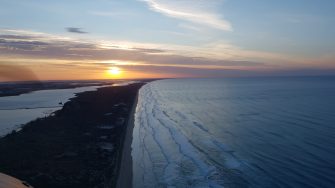
Date: Thursday, October 31, 2019
Project: Eastern Australian Waterbird Survey
Observers: Richard Kingsford & Paul Wainright
Pilot: Tim Dugan
First to the disappointment. Unfortunately, the Coorong was not as spectacular as we were hoping. It certainly wasn’t pulsating with waterbirds the way it was when we first surveyed more than ten years ago. This was at the height of the Millennium Drought when waterbirds were coming from everywhere to the water in this system. Very similar to now. It is a worrying sign, given that there are so few waterbird habitats across Queensland, New South Wales and northern Victoria with water. We had a full suite of trainee observers today from the South Australian, Victorian and Australian Government. We swapped around so that everyone could spend some time in the plane during our counting. This is the great advantage of the Cessna Caravan, with its extra space. We aim to take new observers on about 50 hours of aerial surveys of waterbird for them to get their ‘wings’.
We got away early because today’s forecast was pretty hard from a flying point of view, at 37oC and a 35 knot northerly wind. It meant a lot of turbulence. The extra size of this plane and its air conditioning makes life on aerial survey much more pleasant. The wind was already up when we took off at first light to fly down the Coorong. At one stage, heading into the wind, coming back from the south, we had a ground speed of only 40 knots, which meant the survey was much longer than expected.
Our surveys were, as they always are, separated into a survey of the Murray Mouth, from the barrages near Goolwa through to the end of the most southern barrages, then the North and South Coorong separated at the “Narrows”. We did two counts of all of these systems to get some measure of counting uncertainty. We headed off down the eastern side of the Murray Mouth section, past the mouth of the River Murray where dredges remove the build-up of sand so there is flow out to sea.
Teal, mountain duck, terns, avocets, silver gulls, pelicans and black swans were there in their thousands, along the eastern side of the North Coorong.
There were still lots of these species after we passed ‘the narrows’ in the South Coorong but the numbers dropped significantly once we got to the areas at the most southern end which were shallow and salty.
It is in the South Coorong that the South Australian Government and Australian Government have directed freshwater flows into the South Coorong from the southeast drainage system. They have recently installed a regulator on Salt Creek to control the flows into the Coorong and identify the most effective flow release practice in relation to the ecology of the system.
Down here on the South Coorong, we surveyed the regular pelican colony which was well down on numbers from previous years.
Terns use the Coorong for their feeding, resting on the islands.
Once we had flown down the eastern side, we came back the western side, past the barrages where the cormorants and pelicans congregated because this was where the fish moved between the Coorong and the Lower Lakes. There were also a few fur seals with the same plan.
After lunch, we headed around the two lakes. It is an impressive circuit of a couple of iconic freshwater wetlands in the Murray-Darling Basin. We covered about 540km in our flying, just around the lakes. With the Coorong as well, we ended up flying about 1,300km in the day. As I mentioned yesterday, there were not the numbers of ducks that I thought we would find on the two lakes, in this driest of dry years when there is very little water around. Our surveys are indicating a serious decline in waterbird numbers. There were still reasonably large flocks of terns, cormorants and pelicans.
One of the really exciting finds is that there is good breeding of straw-necked ibis and pied cormorants this year in a few colonies dotted around Lake Alexandrina and Lake Albert.
We finished surveying the rest of Lake Alexandrina in late afternoon. It is a very picturesque lake, apart from its waterbirds and vegetation with various cliffs contrasting the freshwater wetlands along its edges.
Tomorrow we head back up the Murray, surveying to Mildura and then back east, surveying along the Murrumbidgee.
